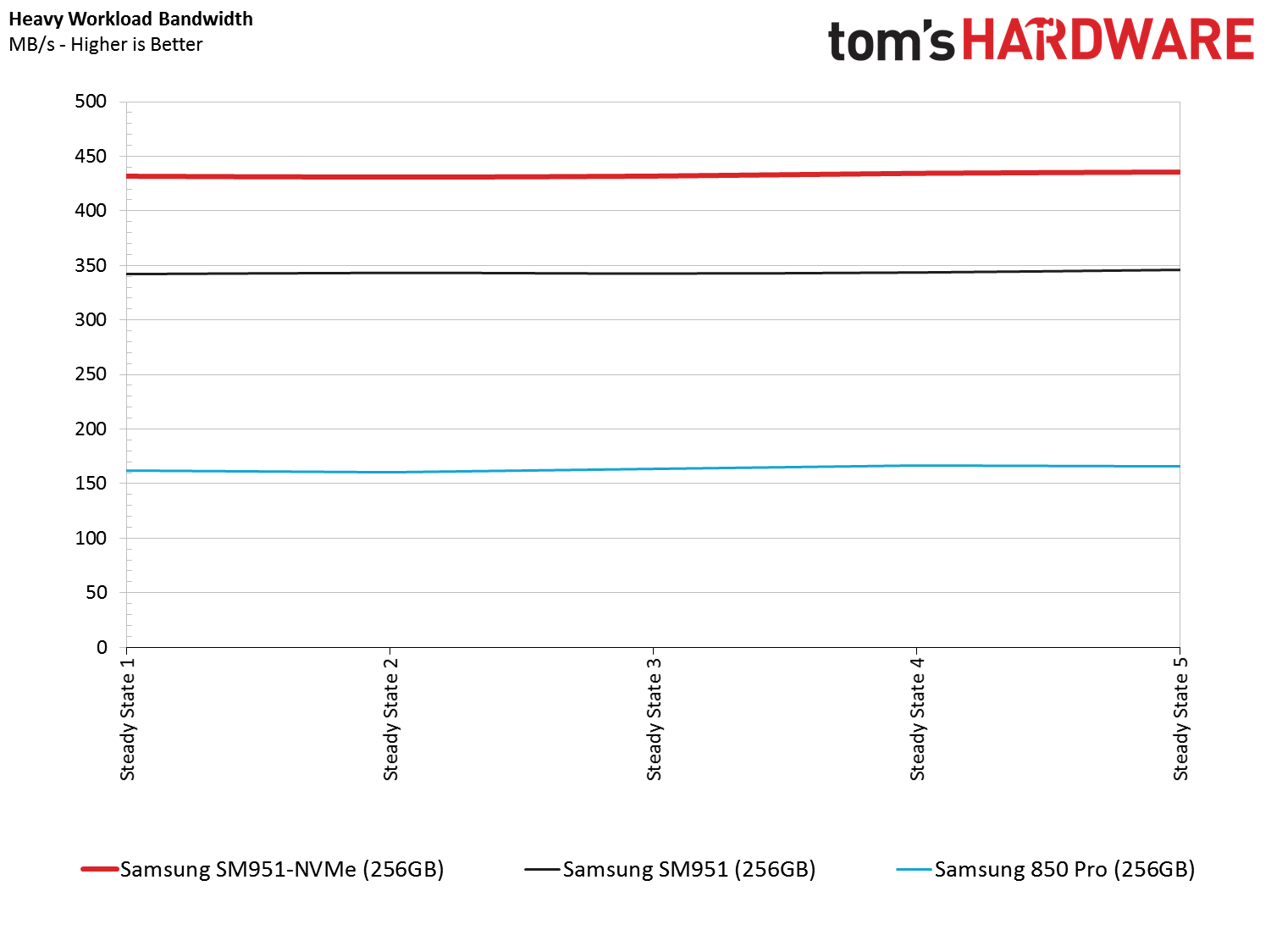Samsung SM951-NVMe Versus AHCI Versus SATA 850 Pro
Why you can trust Tom's Hardware
PCMark 8 Advanced Workload
To learn how we test advanced workload performance, please click here.



The PCMark 8 workload tests use the same data as PCMark 8's real-world benchmarks, but run the modules back to back after preconditioning the drives. After steady state is achieved, time is added between runs to allow the wear-leveling algorithms to recover performance.
We've already mentioned that Samsung SSDs are not as aggressive as some others, so the clean-up time takes longer. Since we're only comparing Samsung products, we don't need to compare the company's wear-leveling to its competition. We will say, however, that Samsung's drives would deliver higher performance in the recovery phase of this test if the five-minute pause between runs was longer. Performance would also improve if Samsung over-provisioned its SSDs. As they sit from the factory, all three drives give you the full LBA span to store data. Of course, you're able to configure these 256GB models with 240GB of user space and 16GB allocated for background activities during the format process.
The throughput results show what we expected after seeing the PCMark 8 real-world results. Again, these three drives behave nearly the same under identical load levels due to their underlying architecture. The difference in performance is clear, though.



The service times show us how long each test iteration takes to complete all of the tasks. The 256GB SM951s deviate less than the 850 Pro 256GB when measuring heavy and light workloads. Most desktop users should focus more on the recovery portion for an indication of daily use performance though, while professional users running write-intensive workstation applications should focus on the middle steady state area.
The SM951 products were designed to provide superior performance for professional users. What makes them so attractive for everyone is their low latency during the recovery phase. Samsung didn't really design the SM951 for light workloads; its success there is just a byproduct of making very good workstation SSDs.
Get Tom's Hardware's best news and in-depth reviews, straight to your inbox.
Current page: PCMark 8 Advanced Workload
Prev Page PCMark 8 Real-World Software Next Page Conclusion
Chris Ramseyer was a senior contributing editor for Tom's Hardware. He tested and reviewed consumer storage.
-
Amdlova hpv-2560 is rated 1.9A and the another one VPV-2560 is 2.7A Maybe you guys need test the power consumption.Reply -
atheus I find the preamble about comparing these M.2 drives to regular SATA drives a little odd. When SSD's first came out, of course they were compared to HDD's because that was precisely the question of the moment — how much more performance can one expect from the more expensive SSD's. With this new generation of SSD's, it's only natural to want to see them compared to the old, cheaper stuff. How else are we going to evaluate whether it's worth it to upgrade?Reply
If it only resulted in an extra 10% on a real-world test, then it wouldn't make any sense to spend double or more on a NVMe drive. With these solid numbers, though, the massive performance leap will be well worth the cost for those who can afford it. -
TechyInAZ Looks great! NVMe is defiantly the ideal solution for users that need high speed/responsive storage.Reply
I wish you guys would of compared this NVMe SSD to the Intel NVMe SSD that just came out. -
CRamseyer The Intel SSD 750 and the Samsung SM951-NVMe will show up side by side soon in another review.Reply -
CRamseyer Test systems: http://www.tomshardware.com/reviews/how-we-test-storage,4058.htmlReply
All three drives were tested in the PCIe test system. They are the only systems setup for testing queue depths beyond 32. -
dwnelson I'm sad the real world chart is misleading. If you show seconds instead of MB/s you'd see it doesn't justify the cost. Sad.Reply -
BoredErica ReplyThe Intel SSD 750 and the Samsung SM951-NVMe will show up side by side soon in another review.
That is a natural comparison and I look forward to reading it.